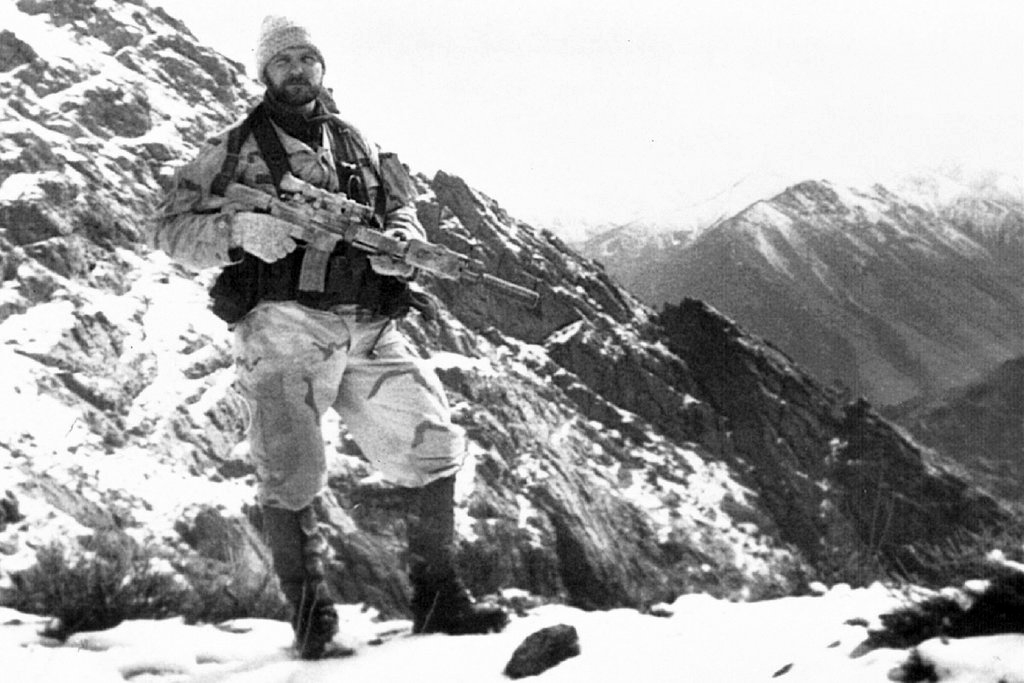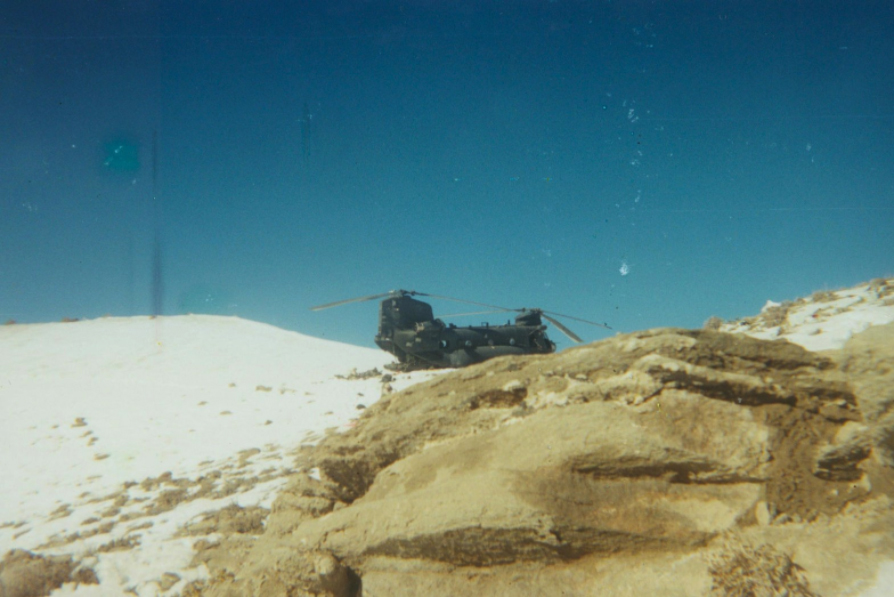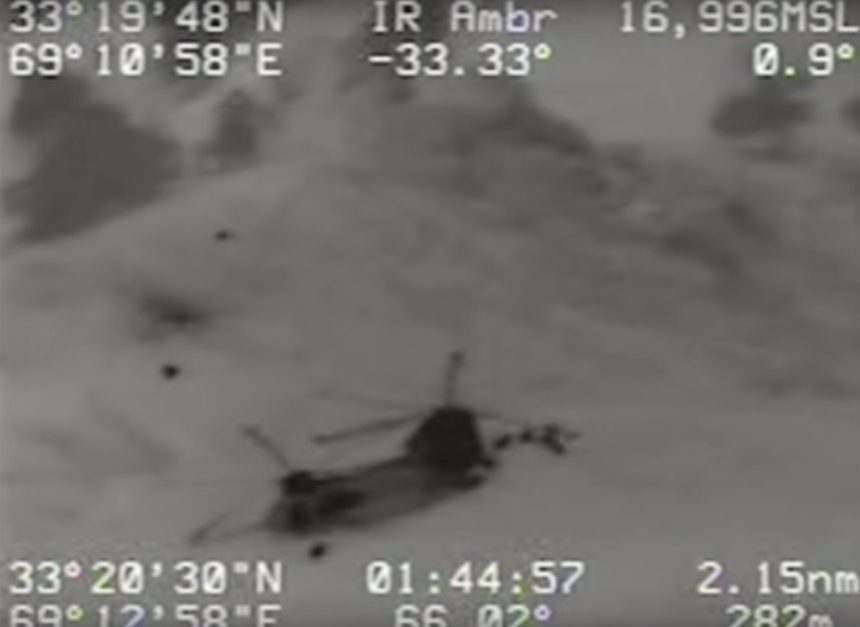TSgt. John Chapman May Have Fought Desperate, Solo Battle to Safeguard Rescuers.
Alone, abandoned, outgunned. USAF Tech Sgt. John Chapman wakes up on a freezing mountaintop in Afghanistan to realize a special operator’s worst nightmare: he is trapped by himself behind enemy lines.
Now he must fight for his life. He is wounded, exposed and low on ammunition as he faces a large number of insurgents bent on making sure he is dead, or worse.
It is Mar. 4 and 5, 2002. The U.S. and coalition led Global War on Terror is at its peak. Coalition conventional and special operations forces are engaged in Operation Anaconda, a combined U.S. military, CIA and international attempt to eliminate Al Qaeda and Taliban forces from the rugged, remote Shahi-Kot Valley in the Arma Mountains of Afghanistan southeast of the Zurmat district.
The operation started hours earlier, and it is already not going well. Among other problems, mechanical delays have caused a U.S. MH-47E Chinook heavy special operations helicopter to attempt to land directly on top of the 10,469-foot Takur-Ghar mountain near sunrise. The helicopter was supposed to insert a long-range surveillance team that would have climbed from their originally planned landing zone (LZ) lower on the mountain to the top of the mountain to provide overwatch for the operation. But the delays compelled planners to save time by landing directly on top of Takur-Ghar. The large helicopter, callsign “Razor 03”, immediately comes under withering machinegun and rocket fire from insurgents dug-in on the mountain summit.

One U.S. Navy SEAL, Petty Officer First Class Neil C. Roberts, slips on a slick of expanding hydraulic fluid on the back ramp of “Razor 03”. Roberts slides out of the helicopter and falls to the ground below. The heavily damaged helicopter with casualties on board attempts to retrieve him, but can no longer remain in the air. It crash lands several miles away near the bottom of the mountain. Petty Officer First Class Neil C. Roberts is left alone on top of the mountain to fight for his life.

The heroic story of Navy SEAL Neil C. Roberts is well-known from books and other media. But information suggests Roberts wasn’t the only man left alone on the summit of Takur-Ghar in a lonely, one-man battle for survival.
Following the fall of Navy SEAL Neil C. Roberts from the back ramp of the first MH-47E helicopter “Razor 03”, a second MH-47E Chinook helicopter, this one with callsign “Razor 04”, returned to an area near the original landing site of “Razor 03” near the top of Takur-Ghar in an attempt to rescue Roberts.
The second MH-47E Chinook helicopter, “Razor 04”, inserted a small team of operators including Navy SEALs and an Air Force special operator in an attempt to rescue Roberts.
One of the rescuers was USAF Tech Sgt. John Chapman. After their insertion the second team of Navy SEALs and Air Force TSgt. Chapman came under heavy insurgent fire at the summit of Takur-Ghar and several were wounded. For the second time that day, they too were forced to withdraw from the summit. But Chapman had been hit and lay motionless on top of the mountain. When the SEALs withdrew under heavy insurgent gunfire, they thought Tech Sgt. John Chapman was killed in the firefight. It turns out they were likely wrong.
Recent information strongly suggests that USAF Tech Sgt. John Chapman survived alone on the summit of Takur-Ghar after the SEAL withdrawal and singlehandedly fought insurgents in hand-to-hand combat. After what appears to be a dramatic close-quarters battle, he did not survive. Now TSgt. John Chapman may receive the United States’ highest military award, the Medal of Honor.

In 2016, USAF Colonel Andrew N. Milani, former commander of the 160th Special Operations Aviation Regiment, the “Night Stalkers”, presented an addendum to an original 2003 report he wrote about the incident that says, “With some of the original uncertainty removed, I can state that the probability now lies more in favor of Chapman surviving the original assault”.
TSgt Chapman has already been awarded the Air Force Cross, but the more recent review of intelligence gathered from the top of Takur-Ghar supports the current push to posthumously award him the Medal of Honor.
As indicated in the documents that awarded him his Air Force Cross, Chapman had, “exchanged fire with the enemy from minimum personal cover until he succumbed to multiple wounds.”
New examination and analysis of video shot from an MQ-1 Predator drone and an AC-130 Spectre gunship above Takur-Ghar may appear to tell the story of remarkable heroism.
At approximately 05:25 local time, video shot from both the MQ-1 Predator drone and from an orbiting AC-130 Spectre gunship showed a person on the ground, almost certainly TSgt. Chapman, moving. And fighting back against insurgents.
“It was really grainy. But there was still somebody up there fighting, and you could see that,” USAF Sgt. Kenny Longfritz, Chapman’s first sergeant at 24th USAF Special Tactics Squadron, said of the Predator drone footage he reviewed after the battle.
The grainy surveillance video goes on to reveal a brutal fight. At 06:00 local time insurgents fired a rocket-propelled grenade at Chapman’s position after he had regained consciousness and joined the battle. At the same time the insurgents attacked Chapman at close range with the RPG, one insurgent charged Chapman’s position in an attempt to overrun him. Chapman killed the insurgent. Moments later another insurgent crawled into Chapman’s foxhole. In the surveillance video, the two can be seen engaged in hand-to-hand combat. Chapman prevailed again, killing the insurgent at arms’-length.
Only moments after Chapman’s desperate one-man stand, two helicopters carrying 75 U.S. Army Rangers were bearing down on Takur-Ghar in a last, massive assault to seize the summit position. It was not known at the time that Chapman was still in position fighting to the death. In his final moments, as the helicopters approach, Chapman appears to rise to provide covering fire for the approaching aircraft- possibly with the dead insurgent’s weapon, maybe with his own, no one knows. As he lays down a field of suppressive fire presumably to protect the incoming helicopter force, insurgents finally gun him down in a withering fusillade of machine-gun fire.
Chapman’s survival and courageous one-man fight against insurgents on top of Takur-Ghar could very well have enabled the approaching helicopter assault force to land more safely than without his suppressive covering fire during his final moments.
In multiple media stories, from the New York Times to Task and Purpose, there are reports that TSgt. John Chapman will receive the Medal of Honor. Journalist Paul Szoldra wrote in an April 20, 2018 article in Task and Purpose that:
“Chapman’s family was notified sometime in March that he would be awarded the Medal of Honor, according to several sources familiar with the matter. A source familiar with the Medal of Honor awards process told me the time between family notification and the award ceremony in Washington is typically a matter of weeks.”

While the Whitehouse has declined to comment yet on any upcoming award for John Chapman, the emerging version of events on top of Takur-Ghar on those days back in 2002 strongly suggest that he demonstrated exceptional selflessness, courage and determination in his solo defense of the mountain top against insurmountable odds. As the United States celebrates its annual Memorial Day holiday to remember servicemen fallen in combat, the new information about USAF Tech Sgt. John Chapman valor seems deserving of the nation’s highest award for heroism.









